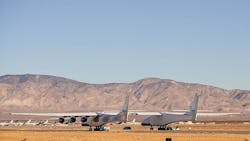Stratolaunch, world’s largest airplane, reaches 40 knots during tests
SEATTLE. The aircraft development team at Stratolaunch Systems Corp., founded by Microsoft co-founder Paul G. Allen, in Seattle, Washington, performed regression testing at the Mojave Air & Space Port on February 24 and 25. The Stratolaunch twin-fuselage aircraft, designed to air-launch rockets into orbit, achieved ground speeds ranging from 10-40 knots during the test series.
On February 24 and February 25, the Stratolaunch team performed taxi tests building on the first taxi test in December. The aircraft reached a top taxi speed of 40 knots (46 mph), officials describe.
(Photos and video: Stratolaunch Systems Corp.)
In Dec. 2017, Stratolaunch marked a milestone on the aircraft’s “journey to flight” -- its first low-speed taxi test. For the first time, the aircraft traveled down the runway under its own power, using all six Pratt & Whitney turbofan engines. The primary purpose of the activity was to test the aircraft’s ability to steer and stop. The ground team monitored a number of systems, including steering, braking, anti-skid, and telemetry. All objectives of this test were achieved – culminating to the aircraft traveling down the runway at 25 knots (28 miles per hour).
Stratolaunch, founded in 2011 by Paul G. Allen, is developing an air-launch platform to make access to space more convenient, reliable, and routine. “We believe that normalizing access to low Earth orbit (LEO) has the potential to redefine our lives by creating more opportunities for commercial, philanthropic and governmental organizations to collect rich and actionable data and drive advancements in science, research, and technology from space,” officials say.
Stratolaunch is the world’s largest aircraft by wingspan and is the largest all-composite plane ever built, officials say. Utilizing six Boeing 747 engines for a payload capacity of over 500,000 pounds and an operational range of approximately 2,000 nautical miles, Stratolaunch is capable of delivering payloads to multiple orbits and inclinations in a single mission.
Stratolaunch’s reusability and air-launch capabilities enable us to take an airport-style approach to operations for launch services. Stratolaunch will take off from a runway, rather than a logistically vulnerable fixed range, which allows us to avoid hazards such as inclement weather, airborne traffic and heavy marine activity. Stratolaunch’s airborne launch platform significantly reduces the risk of costly delays or cancellations, officials add.
Stratolaunch is currently under construction at the Mojave Air & Space Port in Mojave, Calif., and should be fully operational by the end of this decade.





